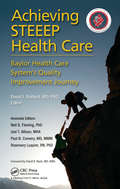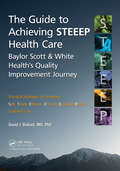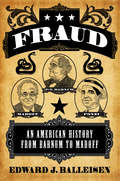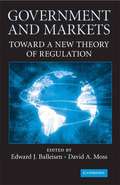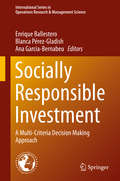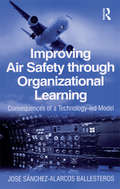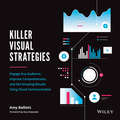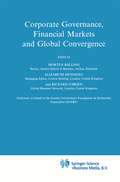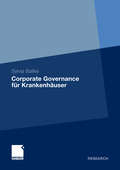- Table View
- List View
Achieving STEEEP Health Care: Baylor Health Care System's Quality Improvement Journey
by David J. BallardWinner of a 2014 Shingo Research and Professional Publication Award!Reaching America‘s true potential to deliver and receive exceptional health care will require not only an immense and concerted effort, but a fundamental change of perspective from medical providers, government officials, industry leaders, and patients alike. The Institute of
The Guide to Achieving STEEEP™ Health Care: Baylor Scott & White Health's Quality Improvement Journey
by David J. Ballard MD PhD.Achieving health care that is safe, timely, effective, efficient, equitable, and patient-centered (STEEEP) is not an endpoint, but a journey. This journey requires a commitment to quality improvement (QI) from the highest levels of leadership combined with the interdependent development of several key components of health care delivery: administrat
Regulating Industrial Internet Through IPR, Data Protection and Competition Law
by Rosa Maria Ballardini Petri Kuoppamäki Olli PitkänenThe digitization of industrial processes has suddenly taken a great leap forward, with burgeoning applications in manufacturing, transportation and numerous other areas. Many stakeholders, however, are uncertain about the opportunities and risks associated with it and what it really means for businesses and national economies. Clarity of legal rules is now a pressing necessity. This book, the first to deal with legal questions related to Industrial Internet, follows a multidisciplinary approach that is instructed by law concerning intellectual property, data protection, competition, contracts and licensing, focusing on business, technology and policy-driven issues. Experts in various relevant fields of science and industry measure the legal tensions created by Industrial Internet in our global economy and propose solutions that are both theoretically valuable and concretely practical, identifying workable business models and practices based on both technical and legal knowledge. Perspectives include the following: regulating Industrial Internet via intellectual property rights (IPR); data ownership versus control over data; artificial intelligence and IPR infringement; patent owning in Industrial Internet; abuse of dominance in Industrial Internet platforms; data collaboration, pooling and hoarding; legal implications of granular versioning technologies; and misuse of information for anticompetitive purposes. The book represents a record of a major collaborative project, held between 2016 and 2019 in Finland, involving a number of universities, technology firms and law firms. As Industrial Internet technologies are already being used in several businesses, it is of paramount importance for the global economy that legal, business and policy-related challenges are promptly analyzed and discussed. This crucially important book not only reveals the legal and policy-related issues that we soon will have to deal with but also facilitates the creation of legislation and policies that promote Industrial-Internet-related technologies and new business opportunities. It will be warmly welcomed by practitioners, patent and other IPR attorneys, innovation economists and companies operating in the Industrial Internet ecosystem, as well as by competition authorities and other policymakers.
Die Struktur kleiner Familienunternehmen in Baden-Württemberg (Beiträge zur Mittelstandsforschung #2)
by Klaus Ballarini Detlef KeeseAuf der Grundlage einer umfangreichen Stichprobe erfolgt eine Beschreibung der Struktur von Kleinbetrieben mit weniger als 20 Beschäftigten in Baden-Württemberg. Damit liegen zum ersten Mal in Deutschland breite Einsichten für kleine Familienunternehmen vor.Besondere Aufmerksamkeit gilt dem betrieblichen Engagement der Inhaberfamilien. Die Analyse der personellen Strukturen ermöglicht Einblicke in die Qualifikationsstruktur, die Versorgungssituation und die Altersvorsorge der im Betrieb tätigen Inhaber und ihrer Angehörigen.Dieses Buch bietet eine Fülle von Materialien für alle, die am wirtschaftlichen Geschehen in der Bundesrepublik Deutschland interessiert sind, insbesondere für die Interessenverbände der Wirtschaft.
Fraud: An American History from Barnum to Madoff
by Edward J. BalleisenThe United States has always proved an inviting home for boosters, sharp dealers, and outright swindlers. Worship of entrepreneurial freedom has complicated the task of distinguishing aggressive salesmanship from unacceptable deceit, especially on the frontiers of innovation. At the same time, competitive pressures have often nudged respectable firms to embrace deception. As a result, fraud has been a key feature of American business since its beginnings. In this sweeping narrative, Edward Balleisen traces the history of fraud in America—and the evolving efforts to combat it—from the age of P. T. Barnum through the eras of Charles Ponzi and Bernie Madoff. Starting with an early nineteenth-century American legal world of "buyer beware," this unprecedented account describes the slow, piecemeal construction of modern regulatory institutions to protect consumers and investors, from the Gilded Age through the New Deal and the Great Society. It concludes with the more recent era of deregulation, which has brought with it a spate of costly frauds, including the savings and loan crisis, corporate accounting scandals, and the recent mortgage-marketing debacle. By tracing how Americans have struggled to foster a vibrant economy without enabling a corrosive level of fraud, this book reminds us that American capitalism rests on an uneasy foundation of social trust.
Fraud: An American History from Barnum to Madoff
by Edward J. BalleisenThe United States has always proved an inviting home for boosters, sharp dealers, and outright swindlers. Worship of entrepreneurial freedom has complicated the task of distinguishing aggressive salesmanship from unacceptable deceit, especially on the frontiers of innovation. At the same time, competitive pressures have often nudged respectable firms to embrace deception. As a result, fraud has been a key feature of American business since its beginnings. In this sweeping narrative, Edward Balleisen traces the history of fraud in America—and the evolving efforts to combat it—from the age of P. T. Barnum through the eras of Charles Ponzi and Bernie Madoff. Starting with an early nineteenth-century American legal world of "buyer beware," this unprecedented account describes the slow, piecemeal construction of modern regulatory institutions to protect consumers and investors, from the Gilded Age through the New Deal and the Great Society. It concludes with the more recent era of deregulation, which has brought with it a spate of costly frauds, including the savings and loan crisis, corporate accounting scandals, and the recent mortgage-marketing debacle. By tracing how Americans have struggled to foster a vibrant economy without enabling a corrosive level of fraud, this book reminds us that American capitalism rests on an uneasy foundation of social trust.
Government and Markets: Toward a New Theory of Regulation (PDF)
by Edward Balleisen David MossAfter two generations of emphasis on governmental inefficiency and the need for deregulation, we now see growing interest in the possibility of constructive governance, alongside public calls for new, smarter regulation. Yet there is a real danger that regulatory reforms will be rooted in outdated ideas. As the financial crisis has shown, neither traditional market failure models nor public choice theory, by themselves, sufficiently inform or explain our current regulatory challenges. Regulatory studies, long neglected in an atmosphere focused on deregulatory work, is in critical need of new models and theories that can guide effective policymaking. This interdisciplinary volume points the way toward the modernization of regulatory theory. Its essays by leading scholars move past predominant approaches, integrating the latest research about the interplay between human behavior, societal needs, and regulatory institutions. The book concludes by setting out a potential research agenda for the social sciences.
Preisaktionen bei Verkehrsdienstleistungen: Ein Beitrag zum Behavioral Pricing (Unternehmensführung und Marketing)
by Benjamin BallensiefenBenjamin Ballensiefen untersucht, ob und in welchem Maße Preisaktionen einen Beitrag zur Verbesserung der Preiswahrnehmung und -beurteilung leisten und somit zur Steigerung der Kundenloyalität beitragen.
Kommunikation im Krankenhaus: Erfolgreich kommunizieren mit Patienten, Arztkollegen und Klinikpersonal
by Gaby Baller Bernhard SchallerDas Buch beschreibt Theorie und Praxis der Kommunikation im Krankenhausalltag zwischen den verschiedenen Berufsgruppen. Dabei wird sowohl die Verständigung unter Kollegen, die Arzt-Patientenkommunikation als auch die Darstellung nach außen hin betrachtet. Zahlreiche Praxisbeispiele ergänzen die Ausführungen. Viele Hinweise und nützliche Tipps für gelingende Gespräche, die Nutzung technischer Kommunikationsmittel im Krankenhausbetrieb, eine Take-Home-Message am Ende jedes Kapitels sowie viele Schaubilder und Checklisten machen das Buch zu einem handlichen Nachschlagewerk für alle Berufsgruppen, die in einem Krankenhaus tätig sind.
Socially Responsible Investment: A Multi-Criteria Decision Making Approach (International Series in Operations Research & Management Science #219)
by Enrique Ballestero Blanca Pérez-Gladish Ana Garcia-BernabeuThis book integrates socially responsible investment into modern portfolio theory from a multi-criteria perspective. Socially responsible investment is a “new deal” championed by the institutional investment and bank sectors, agents that influence mutual funds and other collective investment schemes and which fear that financial strategies without ethical constraints can harm sustainable growth and prosperity. The book shows how to combine financial criteria such as profitability and risk with non-financial criteria such as the protection of the ecosystem, responsible consumption of energy, and healthcare campaigns. The book’s first part presents critical issues in ethical investment, while the second explains in detail the application of goal programming techniques for SRI funds, illustrating their use in actual cases. Part three demonstrates how compromise programming can be applied in the contexts of portfolio selection and risk management. Finally, in its fourth part the book examines the application of other decision-making support methods like the Analytic Hierarchy Process (AHP) framework, the Reference Point Method, and soft computing techniques for portfolio selection.
Multiple Criteria Decision Making and its Applications to Economic Problems
by Enrique Ballestero Carlos RomeroMultiple Criteria Decision Making and its Applications to Economic Problems ties Multiple Criteria Decision Making (MCDM)/Multiple Objective Optimization (MO) and economics together. It describes how MCDM methods (goal programming) can be used in economics. The volume consists of two parts. Part One of the book introduces the MCDM approaches. This first part, comprising Chapters 1-5, is basically an overview of MCDM methods that can most likely be used to address a wide range of economic problems. Readers looking for an in-depth discussion of multi-criteria analysis can grasp and become acquainted with the initial MCDM tools, language and definitions. Part Two, which comprises Chapters 6-8, focuses on the theoretical core of the book. Thus in Chapter 6 an economic meaning is given to several key concepts on MCDM, such as ideal point, distance function, etc. It illustrates how Compromise Programming (CP) can support the standard premise of utility optimisation in economics as well as how it is capable of approximating the standard utility optimum when the decision-makers' preferences are incompletely specified. Chapter 7 deals entirely with production analysis. The main characteristic throughout the Chapter refers to a standard joint production scenario, analysed from the point of view of MCDM schemes. Chapter 8 focuses on the utility specification problem in the n-arguments space within a risk aversion context. A link between Arrows' risk aversion coefficient and CP utility permits this task. The book is intended for postgraduate students and researchers in economics with an OR/MS orientation or in OR/MS with an economic orientation. In short, it attempts to fruitfully link economics and MCDM.
Improving Air Safety through Organizational Learning: Consequences of a Technology-led Model
by Jose Sanchez-Alarcos BallesterosThe key theme of this book is organizational learning and its consequences for the field of aviation safety. Air safety rates have been improving for a long time, demonstrating the effects of a good learning model at work. However, the pace of improvement has almost come to a standstill. Why is this? Many safety improvements have been embodied in technology. New devices and procedures appear almost daily, yet the rate of air safety improvement has dragged in recent years. Improving Air Safety through Organizational Learning explains this situation as being the consequence of a development model supported chiefly by information technology being introduced as an alternative to human operators. This is not a book about the convenience of including or not including IT in aviation, but an open discussion about the adequacy and risks of some practices in the field. Two different but complementary issues emerge. Firstly, a real improvement in air safety requires a different approach, since the present one seems now to be exhausted. Secondly, the current approach has powerful economic roots, and any new approach must deal with this fact, improving safety rates without becoming financially damaging. Consequently the book is divided into two parts. Part one deals with the issue of the present learning model organizing the conclusions around accident reports that show themselves the existence of a problem: the present use of technology makes the system better at doing things already known, while at the same time it makes the whole system worse at dealing with unplanned situations. Part two suggests a new development model, one that makes strong use of technology but at the same time questions every step: what knowledge will disappear from the system and what is the potential effect of that loss?
Improving Air Safety through Organizational Learning: Consequences of a Technology-led Model
by Jose Sanchez-Alarcos BallesterosThe key theme of this book is organizational learning and its consequences for the field of aviation safety. Air safety rates have been improving for a long time, demonstrating the effects of a good learning model at work. However, the pace of improvement has almost come to a standstill. Why is this? Many safety improvements have been embodied in technology. New devices and procedures appear almost daily, yet the rate of air safety improvement has dragged in recent years. Improving Air Safety through Organizational Learning explains this situation as being the consequence of a development model supported chiefly by information technology being introduced as an alternative to human operators. This is not a book about the convenience of including or not including IT in aviation, but an open discussion about the adequacy and risks of some practices in the field. Two different but complementary issues emerge. Firstly, a real improvement in air safety requires a different approach, since the present one seems now to be exhausted. Secondly, the current approach has powerful economic roots, and any new approach must deal with this fact, improving safety rates without becoming financially damaging. Consequently the book is divided into two parts. Part one deals with the issue of the present learning model organizing the conclusions around accident reports that show themselves the existence of a problem: the present use of technology makes the system better at doing things already known, while at the same time it makes the whole system worse at dealing with unplanned situations. Part two suggests a new development model, one that makes strong use of technology but at the same time questions every step: what knowledge will disappear from the system and what is the potential effect of that loss?
Künstliche Intelligenz: Rechtsgrundlagen und Strategien in der Praxis
by Johannes Graf Ballestrem Ulrike Bär Tina Gausling Sebastian Hack Sabine von OelffenAutonomes Fahren, Maschinelles Lernen, Big Data – Im Zuge der Digitalisierung rückt Künstliche Intelligenz (KI) zunehmend in den Fokus unternehmerischer Tätigkeit. Durch KI erzeugte Datensätze und -analysen stehen im Mittelpunkt der Wertschöpfung. Gleichzeitig müssen Entscheider*innen in Unternehmen und Digitalabteilungen die rechtlichen Implikationen der neuen Technologie verstehen: Wie sieht der rechtliche Rahmen für die Beschaffung von Daten mittels KI aus? Welches Haftungsregime gilt für den Einsatz von KI und inwieweit kann die Haftung wirksam beschränkt werden? Wie kann die eigene Wertschöpfungskette vor unberechtigten Zugriffen Dritter geschützt werden? Kann eine konzerninterne Verwertung Steuern auslösen?Dieses Buch gibt Unternehmen einen fundierten und praxisorientierten Einblick in die rechtlichen Möglichkeiten und Grenzen des Einsatzes von KI. Ein Autorenteam aus erfahrenen Rechtsanwält*innen erklärt und zeigt anhand von Erfahrungsbeispielen Strategien und Lösungsmöglichkeiten im Umgang mit KI auf. Das Buch richtet sich (auch) an juristische Laien.
Positive Ethics in Economics: Volume 14, Praxiology: The International Annual of Practical Philosophy and Methodology (Praxiology Ser. #Vol. 14)
by Jérôme Ballet Damien BazinEconomics is often accused of being "a-ethical" - lacking a moral perspective - if not altogether immoral. Its detractors criticize economic models of pure and perfect competition, and claim that economics should be concerned with social effects and strive to be equitable. Yet, these critics fail to understand that the discipline has many dimensions. Economics has also developed a group of concerns directly related to ethics. The presence of practical ethics is evident in the economic analysis of behaviour that incorporates ethical preference, altruism, and a responsible calculation based on norms. It is fair today that economics differentiates ethics from purely financial matters, and the discipline can be associated with morality in man's daily life. Volume 14 of the distinguished "Praxiology" series, examine the concept of positive ethics in economics. While normative ethics moralizes economics, trying to render it more "just," positive ethics is first and foremost a model for the construction of theoretical economic reasoning: it reflects on ethical practices within economics, and introduces a model of reasoning that takes individual ethical behaviour and its after-effects into account. The book is divided into three parts. In "Altruism," the contributors discuss the notion of unselfish concern for the welfare of others, and its place in economic practice. In "Commitment," the authors discuss reason as being central to economic theory, as well as the position of ethical behaviour. In "Responsibility," the idea that man is not an island unto himself, but a being involved in a set of relationships, is examined. If a person is simultaneously responsible for himself and others, then how far does his responsibility extend? "Essays on Positive Ethics in Economics" is thought-provoking volume that will be of interest to economists, policymakers, philosophers, and students of ethics and morality.
Windows To Go: A Guide for Users and IT Professionals
by Joli BallewFind out how to use, manage, deploy, and secure Windows To Go, the ultimate mobile edition of Windows 10, designed to boot directly from a USB stick. This book shows you how to use your Windows To Go drive to work at home and on the move and access local and network resources from anywhere. Readers responsible for deploying Windows To Go drives will also learn how to plan for, provision, deploy, and manage Windows To Go devices in the workplace in order to create an effective mobility solution for their users. A Windows To Go drive can be booted on any PC that meets the Windows 7 or later certification requirements, regardless of the operating system running on that PC.What You'll Learn:Understand how Windows To Go differs from a typical Windows installation on a desktopMeet the necessary hardware and software requirements for Windows To GoBoot your Windows To Go driveUse Windows To Go, at home and on the roadPlan and deploy Windows To Go in the workplaceSecure and protect Windows To Go drivesWho This Book Is For:End users and IT professionals
Der Fabrikbetrieb: Praktische Anleitungen zur Anlage und Verwaltung von Maschinenfabriken und ähnlichen Betrieben sowie zur Kalkulation und Lohnverrechnung
by Albert BallewskiDer Fabrikbetrieb: Praktische Anleitungen zur Anlage und Verwaltung von Maschinenfabriken und ähnlichen Betrieben sowie zur Kalkulation und Lohnverrechnung
by Albert Ballewski C.M. LewinDieser Buchtitel ist Teil des Digitalisierungsprojekts Springer Book Archives mit Publikationen, die seit den Anfängen des Verlags von 1842 erschienen sind. Der Verlag stellt mit diesem Archiv Quellen für die historische wie auch die disziplingeschichtliche Forschung zur Verfügung, die jeweils im historischen Kontext betrachtet werden müssen. Dieser Titel erschien in der Zeit vor 1945 und wird daher in seiner zeittypischen politisch-ideologischen Ausrichtung vom Verlag nicht beworben.
Proceedings of the 2022 International Conference on Economics, Smart Finance and Contemporary Trade (Advances in Economics, Business and Management Research #226)
by Faruk Balli Au Yong Hui Nee Sikandar Ali QalatiThis is an open access book.As a leading role in the global megatrend of scientific innovation, China has been creating a more and more open environment for scientific innovation, increasing the depth and breadth of academic cooperation, and building a community of innovation that benefits all. Such endeavors are making new contributions to the globalization and creating a community of shared future.To adapt to this changing world and China's fast development in the new era, The 2022 International Conference on Economics, Smart Finance and Contemporary Trade to be held in July 2022. This conference takes "bringing together global wisdom in scientific innovation to promote high-quality development" as the theme and focuses on cutting-edge research fields including Economics, Smart Finance and Contemporary Trade. This conference aims to boost development of the Greater Bay Area, expand channels of international academic exchange in science and technology, build a sharing platform of academic resources, promote scientific innovation on the global scale, strengthen academic cooperation between China and the outside world, enhance development of new energy and materials and IT, AI, and biomedicine industries. It also aims to encourage exchange of information on frontiers of research in different areas, connect the most advanced academic resources in China and the world, turn research results into industrial solutions, and bring together talents, technologies and capital to boost development.
Killer Visual Strategies: Engage Any Audience, Improve Comprehension, and Get Amazing Results Using Visual Communication
by Amy BalliettDiscover the foundation, power, and necessity of visual communication with this essential guide Visual communication has changed. It’s gone from being an optional medium for relaying information to an important method for building connections and increasing understanding. We now use visual storytelling to help us establish and strengthen relationships, engage distracted audiences, and bring clarity to complexity. Killer Visual Strategies examines how visual communication has transformed how brands connect with their customers and colleagues alike. It looks at the growing audience demand for quality visual content and how organizations must meet this demand or risk being left behind. Killer Visual Strategies traces the history of visual communication and explores why it now plays an integral role in our daily lives. As Amy Balliett tells the story of this evolving medium, she naturally incorporates visuals, such as timelines and data visualizations throughout. In addition to providing actionable rules to follow for creating high-impact visual content, Balliett also explores the latest trends, including visual search, augmented reality (AR), and virtual reality (VR). Then, she looks forward to what lies ahead in this dynamic field. The book’s topics can benefit readers in a range of professions where visual content is now vital to sharing a message. Learn best practices for visual communication Gain inspiration from countless visual examples Stay on top of the latest trends in visual communication Understand visual communication for marketing, sales, design, HR, and more Killer Visual Strategies provides a clearer picture of the evolution of visual communication as a fundamental part of how a story is told.
Killer Visual Strategies: Engage Any Audience, Improve Comprehension, and Get Amazing Results Using Visual Communication
by Amy BalliettDiscover the foundation, power, and necessity of visual communication with this essential guide Visual communication has changed. It’s gone from being an optional medium for relaying information to an important method for building connections and increasing understanding. We now use visual storytelling to help us establish and strengthen relationships, engage distracted audiences, and bring clarity to complexity. Killer Visual Strategies examines how visual communication has transformed how brands connect with their customers and colleagues alike. It looks at the growing audience demand for quality visual content and how organizations must meet this demand or risk being left behind. Killer Visual Strategies traces the history of visual communication and explores why it now plays an integral role in our daily lives. As Amy Balliett tells the story of this evolving medium, she naturally incorporates visuals, such as timelines and data visualizations throughout. In addition to providing actionable rules to follow for creating high-impact visual content, Balliett also explores the latest trends, including visual search, augmented reality (AR), and virtual reality (VR). Then, she looks forward to what lies ahead in this dynamic field. The book’s topics can benefit readers in a range of professions where visual content is now vital to sharing a message. Learn best practices for visual communication Gain inspiration from countless visual examples Stay on top of the latest trends in visual communication Understand visual communication for marketing, sales, design, HR, and more Killer Visual Strategies provides a clearer picture of the evolution of visual communication as a fundamental part of how a story is told.
Corporate Governance, Financial Markets and Global Convergence (Financial and Monetary Policy Studies #33)
by Morten Balling Elizabeth Hennessy Richard O'Brienfor many years been heavily dependent on bank financing, and this situation has not changed fundamentally. In his paper on stock exchange governance in the European Union Guido Ferrarini discusses the relative merits of member and investor ownership and compares stock exchange regulation in a number of EU countries. Faced with increasing competition amongst themselves and against other enterprises that offer transaction services, such as proprietary trading systems, it is essential for European stock exchanges to improve their efficiency and to generate volume. Large investments in new information technology are necessary in order to preserve competitiveness in agIobaI financial market. The implementation of the ISD has accelerated cross-border transaction activity of member firms and investors and strengthened the pressure for convergence of national stock exchange laws in the EU. In their paper, Francesco Giavazzi and Marco Battaglini look at the role played by banks in privatization processes. Banks can be involved in such processes in several ways. They may themselves be the objects of privatization since in many countries a significant fraction of the banking industry is publicly owned. This is the case in France, Spain and Italy. But banks can also be important buyers of the equity of industrial firms sold by the government if they are allowed to do so. The authors characterize privatizations as a very good opportunity to set up the right environment for the development of new financial intermediaries and in general for asound corporate governance system.
Corporate Governance für Krankenhäuser
by Sylvia BallkeSylvia Ballke geht der Frage nach, welche faktische Bedeutung die Corporate Governance im deutschen Krankenhaussektor hat. Sie rückt sowohl auf konzeptioneller als auch auf empirischer Basis die Corporate Governance für Krankenhäuser, die Hospital Governance, in den Fokus der Betrachtung.
Theology, Morality and Adam Smith (Routledge Studies in the History of Economics)
by Jordan J. BallorThis work details the theological sources and moral significance of the life and work of the Scottish moral philosopher Adam Smith (1723–1790). The panel of contributors deepen our understanding of Adam Smith in his religious and theological context and the significance of this understanding for contemporary moral, economic, and political challenges to modern social life. The chapters cover a broad range of disciplinary and historical concerns, from Smith’s view of providence and his famous "invisible hand" to the role of self-interest and benevolence in Smith’s social and economic thought. A better appreciation for the moral and theological dimensions of Smith’s thought provides not only a better understanding of Smith’s own context and significance in the Scottish Enlightenment, but also promises to assist in meeting the perennial challenges of properly connecting economic realities to moral responsibility. The book is of interest to advanced students and scholars of the history of economic thought, historical and moral theology, intellectual history, political science and philosophy.
Theology, Morality and Adam Smith (Routledge Studies in the History of Economics)
by Jordan J. Ballor Cornelis Van Der KooiThis work details the theological sources and moral significance of the life and work of the Scottish moral philosopher Adam Smith (1723–1790). The panel of contributors deepen our understanding of Adam Smith in his religious and theological context and the significance of this understanding for contemporary moral, economic, and political challenges to modern social life. The chapters cover a broad range of disciplinary and historical concerns, from Smith’s view of providence and his famous "invisible hand" to the role of self-interest and benevolence in Smith’s social and economic thought. A better appreciation for the moral and theological dimensions of Smith’s thought provides not only a better understanding of Smith’s own context and significance in the Scottish Enlightenment, but also promises to assist in meeting the perennial challenges of properly connecting economic realities to moral responsibility. The book is of interest to advanced students and scholars of the history of economic thought, historical and moral theology, intellectual history, political science and philosophy.
